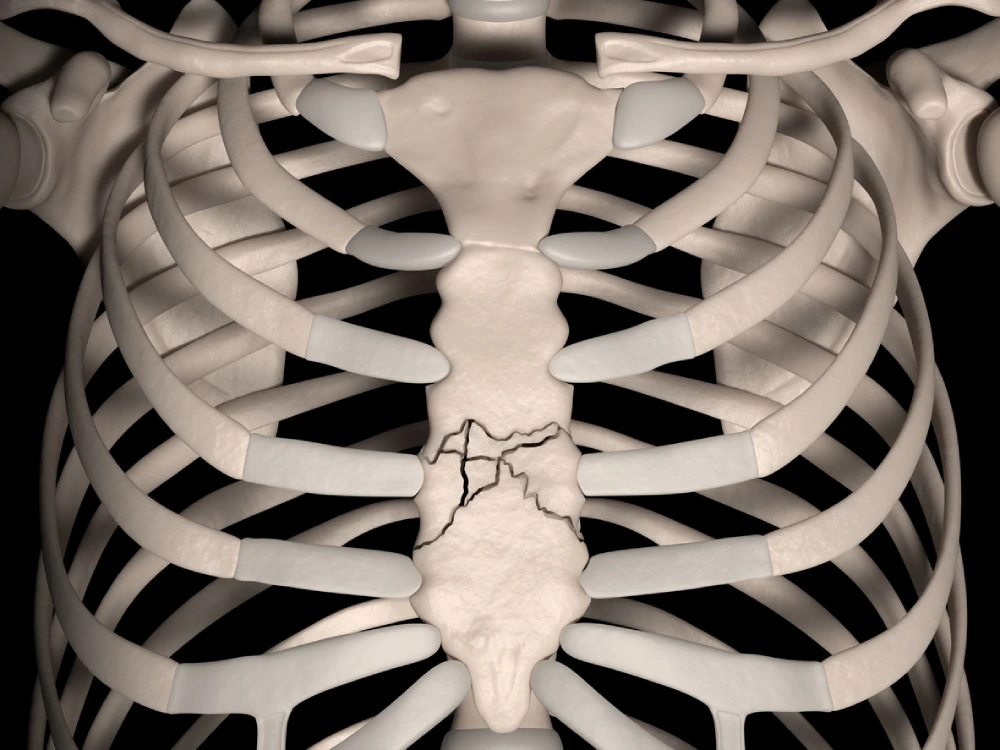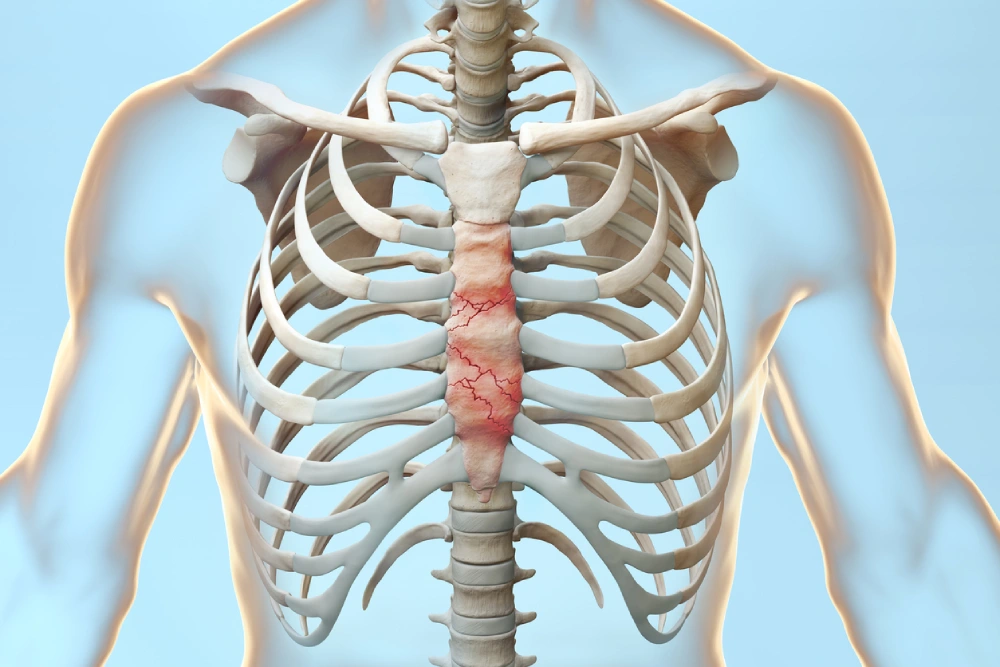
Sarah, a 45-year-old teacher, suffered a sternal fracture after a minor car accident — a reminder that even low-speed impacts can cause chest injuries, particularly to one of the most protected yet vulnerable parts of our anatomy: the sternum.
The Sternum: Your Body’s Natural Shield
Before we delve deeper into Sarah’s journey, it’s important to understand what makes the sternum so special. The sternum, or breastbone, is a flat bone in the center of the chest that connects to the ribs and protects vital organs like the heart and lungs.
The sternum consists of three distinct parts: the manubrium at the top, the body (or gladiolus) in the middle, and the small xiphoid process at the bottom. Together, these sections form a protective barrier that’s both strong and surprisingly flexible. When functioning properly, your sternum allows for the natural expansion and contraction of your chest during breathing while providing structural support for your entire torso. The ribs are also connected to the sternum by cartilage, which can be broken in rare cases.
But what happens when this natural shield becomes compromised? This is where the story of sternal fractures begins.
Understanding Sternal Fractures: More Than Just a Broken Bone
A sternal fracture, simply put, is a break in the breastbone that weakens the anterior chest wall. Sternal fractures are more complex than typical bone injuries because of their location near vital organs. Unlike fractures in arms or legs, sternal fractures carry unique implications because of their location and the vital structures they protect.
When I see a patient with a suspected sternal fracture, I’m not just looking at a broken bone. I’m evaluating the potential for underlying cardiac injury, pulmonary complications, and pulmonary contusion, and the overall impact on the patient’s breathing and circulation.”
Sternal fractures typically result from significant blunt force trauma to the chest. The most common cause is motor vehicle collisions, particularly when the driver or passenger’s chest strikes the steering wheel or dashboard. However, these injuries can also occur from:

- Sports-related collisions
- Falls from significant heights
- Direct blows to the chest, like in assaults
- Workplace accidents
- Physical altercations
The mechanism of injury is crucial in understanding the severity and potential complications associated with sternal fractures, together with the patient’s characteristics, such as the presence of osteoporosis, being a pedestrian in an accident versus a car, and being a passenger in older vehicles that offer less protection.
Sarah’s Story Continues: Recognising the Signs of Sternal Injury
Returning to Sarah’s experience, the initial moments after her accident were confusing. She felt shaken but initially thought she was uninjured. It wasn’t until several minutes later, as the adrenaline began to wear off, that she noticed a deep, aching pain in the center of her chest.
“It felt different from anything I’d experienced before,” Sarah recalls. “It wasn’t sharp like when you pull a muscle. It was this constant, pressing pain that seemed to get worse with every breath.”
This description aligns perfectly with the classic symptoms of sternal fractures:
Primary symptoms include:
- Central chest pain that worsens with movement or deep breathing
- Tenderness over the breastbone
- Swelling or bruising over the sternum
- Difficulty taking deep breaths
- Pain that radiates to the shoulders or arms
Secondary symptoms may include:
- Shortness of breath
- Rapid heartbeat
- Anxiety or a feeling of impending doom
- Nausea or dizziness
- Difficulty sleeping due to pain
What makes sternal fracture symptoms particularly challenging is that they can sometimes be subtle initially, especially if the patient is in shock or experiencing adrenaline from the traumatic event. This delayed recognition can lead to delayed treatment, potentially complicating the healing process.
The Emergency Room Experience: Diagnosis and Initial Treatment
When Sarah arrived at the emergency department, she encountered a well-orchestrated system designed to quickly assess and treat chest trauma patients. The triage nurse, experienced in recognising potential serious injuries, immediately noted Sarah’s mechanism of injury and chest pain, prioritising her for rapid evaluation.
With suspected sternal fractures, we follow a systematic approach, time is critical, not just for the fracture itself, but for any associated injuries that might be life-threatening.”
Diagnostic Procedures for Sternal Fractures
The diagnostic workup for suspected sternal fractures typically includes several key components:
Physical Examination: The healthcare provider begins with a thorough physical examination, carefully palpating the chest wall to identify areas of tenderness, deformity, or instability. They’ll also assess breathing patterns, listen to heart and lung sounds, and check for signs of associated injuries. A thorough history is also always taken.

Imaging Studies:
- Chest X-rays: While standard chest X-rays can sometimes miss sternal fractures, they’re still the initial imaging study of choice. They help rule out other chest injuries and may show indirect signs of a sternal fracture.
- CT Scan: Computed tomography is the gold standard for diagnosing sternal fractures. CT scans provide detailed images that can reveal even subtle fractures and help assess for associated injuries.
- Lateral Chest X-ray: This specialised view can sometimes better visualise sternal fractures than standard frontal chest X-rays.
Cardiac Monitoring: Because of the sternum’s proximity to the heart, patients with sternal fractures often receive cardiac monitoring to watch for signs of heart injury or rhythm abnormalities.
Laboratory Tests: Blood tests, including cardiac enzymes, may be ordered to check for heart muscle damage that could indicate associated cardiac injury.
In Sarah’s case, the CT scan clearly showed a fracture through the body of her sternum. Fortunately, initial tests showed no signs of underlying heart or lung injury, which significantly improved her prognosis.
Classification and Types of Sternal Fractures
Not all sternal fractures are created equal. Medical professionals classify these injuries based on several factors, each affecting treatment decisions and prognosis.
Location-Based Classification:
- Manubrium Fractures: These occur in the upper portion of the sternum and are often associated with clavicle or upper rib fractures. They’re less common but can be more complex to treat.
- Sternal Body Fractures: The most common type occurs in the middle section of the sternum. These are often the result of direct frontal impact and may be associated with underlying cardiac injury.
- Xiphoid Process Fractures: Less common and typically less severe, these fractures occur at the bottom tip of the sternum.
Stability Classification:
- Stable Fractures: The bone fragments remain in proper alignment, and the chest wall maintains its structural integrity. These typically have better outcomes and may be managed conservatively.
- Unstable Fractures: Characterised by significant displacement of bone fragments, these fractures may create a “flail chest” condition where the chest wall moves paradoxically during breathing.
Associated Injury Classification:
- Isolated Sternal Fractures: These occur without significant associated injuries and generally have excellent prognoses.
- Complex Sternal Fractures: These involve additional injuries to the heart, lungs, major blood vessels, or other chest structures, requiring more intensive treatment and monitoring.
Treatment Approaches: From Conservative to Surgical
The treatment of sternal fractures has evolved significantly over the past several decades. The approach depends on numerous factors, including fracture type, patient age, associated injuries, and overall health status.
Conservative Treatment: The Foundation of Care
For most patients with stable, isolated sternal fractures, conservative treatment remains the cornerstone of management. This approach focuses on pain control, monitoring for complications, and supporting the body’s natural healing process.
Pain Management: Effective pain control is crucial for proper healing and preventing complications. Treatment typically includes:

- Non-steroidal anti-inflammatory drugs (NSAIDs) for pain and inflammation
- Prescribed pain medications for severe pain
- Muscle relaxants for associated muscle spasms
- Topical analgesics for localised relief
Activity Modification: Patients are typically advised to:
- Avoid heavy lifting (usually anything over 10-15 pounds initially)
- Limit overhead arm movements
- Use proper body mechanics when moving
- Gradually increase activity as healing progresses
Breathing Exercises: To prevent pulmonary complications, patients are taught specific breathing exercises and may work with respiratory therapists.
Surgical Treatment: When Surgical Fixation is Necessary
While most sternal fractures heal well with conservative treatment, certain situations may require surgical intervention:
Indications for Surgery:
- Severely displaced fractures
- Unstable chest wall (flail chest)
- Associated cardiac or major vascular injury
- Failed conservative treatment
- Chronic pain syndromes
Surgical Techniques: Modern surgical repair of sternal fractures may involve:
- Internal fixation with plates and screws
- Wire cerclage techniques
- Bioabsorbable implants
- Minimally invasive approaches
Mr Scarci, a cardiothoracic surgeon specialising in chest wall reconstruction, notes: “The decision to operate is never taken lightly. We carefully weigh the risks and benefits for each patient, considering not just the fracture itself but the patient’s overall health and likelihood of successful healing. A small operation can significantly reduce the risk of complications and mortality rate, especially in elderly patients.”
Sarah’s Healing Journey: The Road to Recovery
Sarah’s treatment plan exemplified the conservative approach. Her medical team, led by Mr Scarci, developed a comprehensive care plan that addressed not just her physical injury but also her emotional well-being. Surgical decisions are made carefully, balancing potential risks and benefits for each patient.
Week 1-2: Acute Phase Management
The first two weeks after Sarah’s injury were the most challenging. The pain was significant, making simple activities like getting dressed or sleeping difficult. Her medical team emphasised the importance of pain control and rest, not just for comfort but to prevent complications.
“I learned that controlling pain wasn’t about being tough or suffering through it,” Sarah reflects. “It was about giving my body the best chance to heal properly.”
During this phase, Sarah’s care included:
- Regular follow-up appointments for monitoring
- Chest X-rays to ensure no complications
- Pain medication adjustment based on her response
- Education about activity restrictions and warning signs
Week 3-6: Early Healing Phase
As the acute pain began to subside, Sarah entered what her doctors called the early healing phase. This period focused on gradual mobilisation and preventing complications.
Physical therapy played a crucial role during this time. Sarah worked with Lisa Martinez, a physical therapist experienced in treating chest injuries. “The goal isn’t to push through pain,” Lisa explained, “but to maintain mobility and strength while respecting the healing process.”
Sarah’s physical therapy program included:
- Gentle range of motion exercises
- Breathing exercises to maintain lung capacity
- Posture training to prevent compensation patterns
- Gradual strengthening of surrounding muscles
Week 6-12: Progressive Recovery
The middle phase of recovery brought both challenges and encouragement. Sarah began to feel more like herself, but she also had to confront the reality that full healing would take time.
“I was eager to get back to normal,” Sarah admits, “but I learned that rushing the process could actually set me back.”
During this phase, treatment focused on:
- Increasing activity tolerance
- Returning to work with accommodations
- Addressing any persistent symptoms
- Planning for long-term recovery
Month 3-6: Late Healing and Functional Recovery
As Sarah moved into the later phases of healing, the focus shifted from managing acute symptoms to optimising function and preventing long-term complications.
Complications and Long-term Considerations
While many patients with sternal fractures recover completely, it’s important to understand potential complications and long-term considerations.
Immediate Complications
Respiratory Complications:
- Pneumonia due to shallow breathing from pain and atelectasis
- Pneumothorax (collapsed lung)
- Respiratory failure in severe cases
Cardiac Complications:
- Cardiac contusion (heart muscle bruising)
- Rhythm abnormalities
- Pericardial effusion (fluid around the heart)
Infection:
- Particularly relevant in cases requiring surgery
- Can significantly complicate healing
Long-term Considerations
- Chronic Pain: Some patients develop chronic pain syndromes that persist beyond the expected healing time. These may require specialised pain management approaches.
- Chest Wall Deformity: In cases of severe fractures or complications, patients may develop visible chest wall deformities that can affect both function and appearance.
- Reduced Exercise Tolerance: Some patients report long-term limitations in their ability to perform strenuous activities, particularly those involving the chest muscles.
- Psychological Impact: The trauma associated with the initial injury, combined with the prolonged recovery process, can have lasting psychological effects that may require professional support.
Prevention Strategies: Protecting Your Chest Wall
While not all accidents can be prevented, there are strategies that can reduce the risk of sternal fractures:

Vehicle Safety
- Always wear seatbelts properly positioned across the chest
- Ensure proper distance from the steering wheel (at least 10 inches)
- Maintain vehicles in good working condition
- Drive defensively and avoid distractions
Sports Safety
- Use appropriate protective gear for high-risk sports
- Follow proper techniques and training protocols
- Ensure playing surfaces and equipment meet safety standards
Workplace Safety
- Follow occupational safety guidelines
- Use appropriate personal protective equipment
- Report and address safety hazards promptly
Home Safety
- Use appropriate safety equipment when working at heights
- Maintain good lighting and clear pathways
- Address home hazards promptly
The Role of Support Systems in Recovery
Throughout Sarah’s journey, one factor consistently emerged as crucial to her recovery: the support system around her. This included not just her medical team but also her family, friends, and workplace.
Family Support
Sarah’s husband, Mark, took on additional responsibilities around the house and accompanied her to medical appointments. “Having someone who understood what I was going through made all the difference,” Sarah notes.
Workplace Accommodations
Sarah’s school district worked with her to provide necessary accommodations during her recovery, including modified duties and flexible scheduling.
Peer Support
Connecting with others who had experienced similar injuries provided Sarah with practical advice and emotional support that complemented her medical care.
Innovations in Sternal Fracture Treatment
The field of chest trauma treatment continues to evolve, with new technologies and techniques improving outcomes for patients with sternal fractures.

Advanced Imaging
- 3D CT reconstruction for better visualisation
- MRI for soft tissue evaluation
- Ultrasound for monitoring healing progress
Surgical Advances
- Bioabsorbable fixation materials
- Minimally invasive techniques
- Patient-specific implants using 3D printing
Pain Management Innovations
- Targeted nerve blocks
- Advanced medication delivery systems
- Non-pharmacological pain management techniques
Rehabilitation Technology
- Virtual reality for pain management and therapy
- Wearable devices for monitoring activity and recovery
- Telemedicine for remote monitoring and support
Living with a Sternal Fracture: Long-term Perspectives
Six months after her accident, Sarah reflected on her journey with a sternal fracture. “It wasn’t just about the physical healing,” she explains. “It changed how I think about my body, about safety, and about appreciating the things I took for granted.”
Physical Recovery
Most patients with isolated sternal fractures can expect excellent long-term outcomes. The sternum typically heals well, and most people return to their previous level of activity within 6-12 months.
Emotional Recovery
The psychological impact of trauma and prolonged recovery shouldn’t be underestimated. Many patients benefit from counseling or support groups during their recovery process.
Lifestyle Modifications
Some patients choose to make permanent lifestyle changes following their injury, such as:
- Increased focus on safety measures
- Regular exercise to maintain chest wall strength
- Stress management techniques
- Regular medical follow-up care
The Future of Sternal Fracture Care

As our understanding of chest wall injuries continues to evolve, several trends are shaping the future of sternal fracture care:
- Personalised Medicine
Treatment approaches are becoming increasingly individualised based on patient-specific factors, including genetics, healing capacity, and lifestyle factors.
- Regenerative Medicine
Research into stem cell therapy and tissue engineering may offer new options for patients with complex fractures or healing complications.
- Prevention Technology
Advanced vehicle safety systems and protective equipment continue to reduce the incidence and severity of chest trauma.
- Predictive Analytics
Machine learning and artificial intelligence are being used to better predict outcomes and optimise treatment plans.
Conclusion: A Story of Resilience and Healing
Sarah’s journey with a sternal fracture illustrates the complex interplay of medical science, personal resilience, and support systems that contribute to successful healing. While her experience was challenging, it also demonstrated the remarkable ability of the human body to recover from significant trauma when provided with appropriate care and time.
For healthcare providers, Sarah’s story underscores the importance of comprehensive, patient-centered care that addresses not just the immediate injury but the entire healing process. For patients and families facing similar situations, it offers hope and practical insights into what the recovery journey might entail.
The management of sternal fractures continues to evolve, with new techniques and technologies offering improved outcomes for patients. However, the fundamental principles remain constant: careful assessment, appropriate treatment, patience with the healing process, and comprehensive support for the patient’s physical and emotional well-being.
As Sarah concluded when reflecting on her experience: “I wouldn’t wish a sternal fracture on anyone, but going through it taught me things about strength and healing that I never knew before. My body is more resilient than I ever imagined, and with the right care and support, it’s amazing what we can overcome.”
For anyone facing a sternal fracture diagnosis, remember that while the journey may be challenging, the vast majority of patients go on to make complete recoveries and return to their normal activities. With proper medical care, patience, and support, the human body’s capacity for healing truly is remarkable.
The story of sternal fractures is ultimately one of hope—a testament to medical advancement, human resilience, and the power of comprehensive, compassionate care in facilitating healing and recovery.
If you or someone you know has experienced chest trauma, it’s important to seek immediate medical attention. This article is for educational purposes only and should not replace professional medical advice, diagnosis, or treatment.